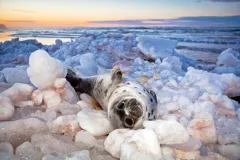Ice-Loving Seals and the Loss of Sea Ice

The threat that climate change poses to polar bears has received a lot of attention, but they are not the only Arctic species at risk. Ice-loving seals, such as harp, hooded and ringed seals, are among the many species threatened by climate change. Recent predictions suggest that warming seawater and air will melt 20 percent or more of the Arctic's ice cover in the next 40 years—a scary statistic for the many species in the Arctic that rely on seasonal ice cover for vital activities such as breeding and eating.
Harp seals (Pagophilus groenlandicus) are a prime example of why sea ice matters. These seals give birth to pure white pups on Arctic ice floes. During their first six weeks of life, before they grow large enough to spend most of their time in the water, the pups use the ice as platforms for nursing and resting. But as ice melts more quickly, pups are forced into the water before they are ready to fend for themselves. These young pups are especially at risk for hypothermia, starvation, and being crushed by moving ice in the Arctic.
Yearlings (seals between one and two years old) are also harmed by declining sea ice because their food is found along the edges of the ice. Harp seals feed primarily on small crustaceans and fish, such as krill, capelin and sand lance, which both use the sea ice edge as shelter from their own predators and feed on algae associated with the sea ice edge.
You don’t have to go to the Artic to see the effects of declining sea ice. After a summer in their northern feeding grounds, harp seals migrate south. Some adults stop to spend the winter at breeding grounds in the Gulf of St. Lawrence or along the coast of Newfoundland. However, other harp seals, mostly immature seals and adult males, may continue south. Some seals swim as far south as New England and the mid-Atlantic, where since 1991, over 3,000 sick or dead harp seals have stranded on U.S. beaches. As part of a team of four scientists from the Duke University Marine Lab, we wanted to figure out whether these strandings were related to the melting Arctic ice.
We found that most of the stranded seals were yearlings, which are particularly susceptible to stranding because they tend to be smaller, weaker, and have less experience fending for themselves. Young males stranded more frequently than young females, perhaps because of their tendency to wander further than females. This wanderlust is not well understood, but it is likely to be physically stressful, further weakening the male seals. Most importantly, we found a clear relationship between the number of young seals stranded and loss of sea ice.
The increase in stranded young seals in low-ice years does not bode well for other ice-dependent marine animals, including polar bears and several species of whales, seals, and seabirds. If ice continues to decrease across the Arctic, these species will need to adapt to the changing environment in order to survive, but we do not yet know which species are capable of adaptation and at what rate.
Genetic diversity—the amount of DNA variation within a species—can provide some indication of a species’ general fitness, including their ability to bounce back from threats such as disease and changing environmental conditions. Fortunately, we found high genetic diversity in harp seals sampled in the Northeast. However, it remains to be seen whether or not harp seals will be capable of adapting at the rate necessary to respond to the already occurring rapid declines in sea ice cover.

